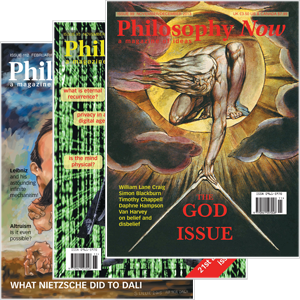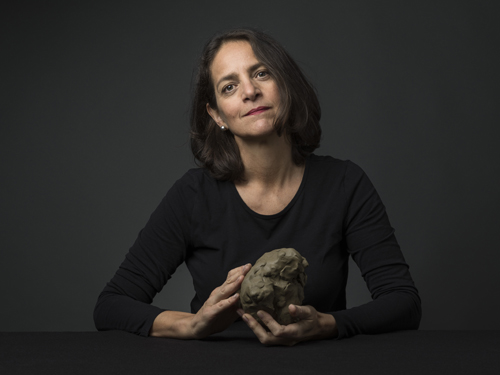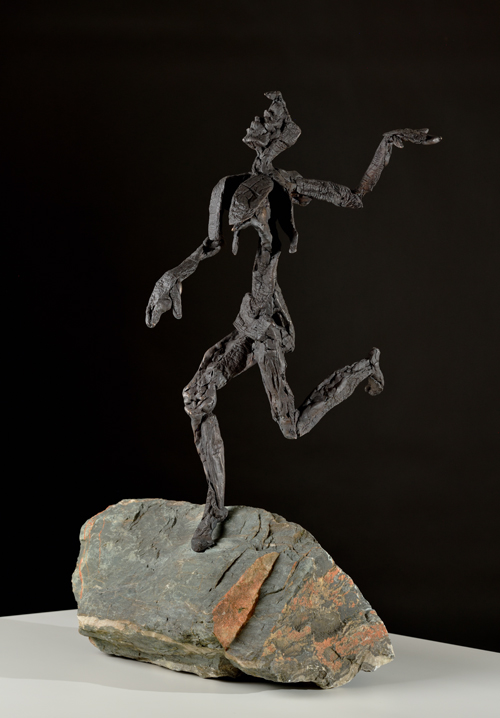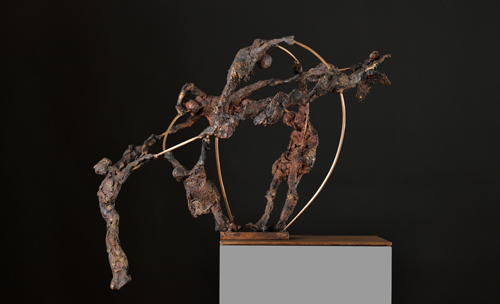
Your complimentary articles
You’ve read one of your four complimentary articles for this month.
You can read four articles free per month. To have complete access to the thousands of philosophy articles on this site, please
Interview
Dr. Gindi
Dr. Gindi, sculptor, has a philosophical conversation with Richard Baron about sensation, life, infinity and, you guessed it, sculpture.
Dr. Gindi is one of Switzerland’s foremost sculptors, whose work has been exhibited in many countries. Her bronzes are an invitation to the viewer to rethink their relationship to the world. We see a person, a face, a hand, but we know that there is more to grasp, something that’s captured by a tension between what’s there in the bronze and what is not there. Through this, Dr. Gindi wants to lead us into an infinite range of possibilities, and thereby make us reflect on the fact that life too is full of possibilities.

Dr. Gindi courtesy of Braschler/fischer
Dr. Gindi, your work is characterized by an inquiry into the human condition. As a philosopher-sculptor, you seek to usher us closer to finding our place in the universe. What are we searching for? And why?
There’s an awe-inspiring freedom in recognizing the choice to transform what’s in front of us. Every individual has the profound opportunity to shape their own journey. In my art, I strive to reflect both the freedom and the responsibility gifted to us: How do we make sense of this momentous choice, the long search, and the sacred journey that we’re on?
We often believe wholeheartedly that if we achieve something we desire, then something even more significant will come beyond the thing itself. Part of the way we live our lives is striving for these particularities; indeed, it’s part of the human condition. But there’s also an oft-ignored part of our existence which exerts a gravitational pull that’s just as strong: a desire for belonging, for peace with oneself and one’s surroundings, accompanied by the ability to stand at the precipice beholding the big picture.
But to what extent do we have the choice to transform the universe we’re thrown into? And how does that search manifest itself in your sculptural work?
While we may not be able to change the cards we’re dealt, we can enjoy the fruits of our efforts to shape ourselves within our circumstances. This is part of what drives my interest in sculpting: I start with one thing, a pile of clay, or a rough piece of metal, that becomes something dramatically different. And indeed, this too is part of the human journey. What seems to be bound by rules, patterns, and inevitabilities can shape and shift with an awareness of what’s beyond our present circumstances. I discover this most deeply in my work, but it reverberates throughout life, like a familiar song.
Ludwig Wittgenstein once discussed a rule-following paradox. He wrote, “This was our paradox: no course of action could be determined by a rule because any course of action can be made out to accord with the rule” (Philosophical Investigations, 1953). What this means is that rules always involve interpretation: and that we can make any course of action either accord or conflict with a particular rule. Wittgenstein’s skepticism about rule-following concerns language; but for me it touches upon our position in the universe. My work is about exposing the fictitiousness of the rules that seem so fixed in our lives. I believe we’re endlessly free to transform our world through what we create, whether art, or practice, or ideas. When I find myself feeling trapped by the rules that creep over my mind, I ask myself how I can use this prodding to fuel and deepen the intricacies of my work. I love to lose myself in the push and pull.
How much of a sense of continuity do you see in your work? You’ve created series of works, such as Finding Ways and Integuments of Existence. But is there a larger sequence that encompasses all your work? Or are there points at which you consciously make a fresh start?
Infinity is the overarching concept in my work. I suppose I see another connection with Wittgenstein here; but whereas he concerned himself with the nature of philosophical problems, I see myself as exploring the nature of infinity. This philosophical puzzle has captivated me for a long time: how to capture such a grand, abstract, and sublime idea as the infinite using quite ordinary, concrete, and simple materials. My sculptures materialize certain states of infinity – of the infinite possibilities of life – since one work couldn’t possibly encompass every aspect of infinity: because sculptures occupy space and time, they’re limited to embodying particular snapshots of infinity. I believe that the infinite reveals itself in every moment if we’re able to let go of our grasp on the temporal moment, take the right orientation, and let it wash over us like the lulling waves of the sea. There is great freedom, too, in realizing that so much of our desire for the worldly and the finite is rooted in a much deeper hunger for the infinite. And the infinite allows room for fresh starts. We can, with the right set of choices, opt to begin again, and again.
Again I see a parallel here between my work and the human search for meaning. Striving for the particular can result in an intense feeling of loss and alienation. We can find our way back, though, when we’re in touch with the infinite. We experience our place in the world, as well as the place of others, and that place – every place one might consider – is vindicated. We feel a sense of what’s sometimes called ‘oneness’. When we connect with the infinite, it is impossible not to feel a sense of true belonging in the world and among our fellow travellers.
There are a myriad ways to transcend the ordinary. For me, philosophy is an open system and I’m not dogmatic about how we interpret infinity or transcendence. As such, different works demonstrate transcendence in different moments and at different times. My sculpture Meandering Souls is about striving for the infinite alongside one’s fellow travellers. Self-Laceration Beyond Recognition explores a dark contrast to what happens when we connect with that aspect of infinity. Hill of Indulgence explores the process of letting go that’s necessary to ease immersing into the infinite.
As you create your sculptures, how aware are you of how someone viewing them might have the same sensations as you, either in reality, or in their imagination if they can only think about what it would be like to touch them?
There are, of course, debates about whether the red I see is the same red you see. One of the ancient Greeks, Aenesidemus, theorized that perception is relative to the observer, the object, and the conditions of perception at the moment the perception occurs. But that relativism raises a problem: surely we have some accord when it comes to perception? We’re able to move through the world because, for example, when we meet something, like an obstacle in the street, we all see it and move around it. And our ability to coordinate with each other should prove that there’s something similar in how we perceive the world. But what is that similarity?
Some philosophers have supposed that there’s something special about touch. The Molyneux Problem [see last Issue, Ed], which John Locke famously discussed with William Molyneux, asks whether a congenitally blind person could visually identify an object he’d previously touched if he suddenly developed the ability to see. Suppose he touched a sphere, and then was suddenly sighted: would he know when he was looking at a sphere? Although much ink has been spilled on this matter for the last three hundred plus years, certain advances in science have implied ‘No’. But it’s still complicated.

The Hill of Indulgence
Precisely, that’s where I’m prodding you with my question. Do you think that imagined touch allows you to share your understanding of life and the infinite in a more direct way than the look of your sculptures? Does it create a direct channel from your mind to the mind of someone viewing your work?
Touch is very important to me, it’s about feeling the world. But one interesting thing about sculpture is that it isn’t only about touch. People who view my work only through photos can still be deeply affected by their experience. Indeed, I often hear from collectors of my work who testify to just such a phenomenon. So sculpture is just as much about imagined touch and how the individual’s intimate connection with the tactile world influences their emotional, intellectual, and spiritual worlds. So you see, there are many different levels to touch, most of which are not just about what it would feel like to literally run your fingers across the sculpture. When you see a jagged shape, it evokes an emotional sensation. How do you connect with and interpret something jagged, versus totally smooth? What feelings arise for you? You might feel a deep desire to recoil or turn away, or you might be reminded of a traumatic injury you received as a child scrambling along in a forbidden place, and in a flash, be transported emotionally to those past feelings. Further, there’s an intellectual component. The grooves, shapes, and textures of a sculpture all represent something we can describe using language. And what intellectual or symbolic meaning is presented in a sculpture will change the experience of imagined touch, since touching, say, a grieving man, will be a different experience from touching the slope of a hill. The fact that all my pieces contain an exploration of the infinite means that there’s a spiritual component to touch as well.
The relationship between my mind, the sculpture, and the viewer, is an ethereal one. I envision all relationships as dynamic moments woven together like a tapestry, and dependent upon all the individual threads within them. The experience of my art by the perceiver is as direct as it could be, sure: but then I wonder, how direct can any relationship be? In the closest friendships and marriages there are differences in interpretation and understanding. We all encounter each other through the lenses of our past and current relationships. But in effect, yes, I think that both vision and imagined touch allow the viewer to encounter, at least in some part, the way that I explore life and the infinite within my sculptures.
Some of your work has been described as ‘semi-figurative’. I wonder how you see the non-figurative element: is it the half that’s not defined in terms to which we can immediately apply our standard figurative categories, like faces and hands? And does the non-figurative element allow us to freely create interpretation?
‘Semi-figurative’ might be a good way to describe it. In any piece of art, the more non-figurative, the more open it is. But I employ both approaches. My sense is that in my work viewers can often find elements that fit into standard categories as well as those that don’t. To create the most impact, it’s important to me that I leave room for imagination, interpretation, and phantasm. Even so, I like there to be the opportunity to see and observe the familiar. This gives viewers some kind of intellectual and experiential baseline from which to begin. My hope is that this foundation can serve as a permeable threshold through which they can then imagine the other half. I believe that we need both groundedness and abstraction to remind us of both the reality and the possibilities at play in our lives. Since art imitates life, my intention is to hold up this mirror with my work.
So the lack of fully meaning-laden symbols allows us to exercise our minds. Do you think that through semi-figurative sculptures we bring our own personalities to the exercise of viewing, in order to relate to the work in a way that’s satisfactory to us?
Yes. Much of what goes into interpreting a sculpture is about what the subconscious is doing in the background to make sense of what we’re beholding. But here the figurative is also essential. One of the things I particularly like about the figurative element is that the sculptures can especially reflect moments of change. Heraclitus famously said that one never steps into the same river twice. He believed that everything is in flux, and also that opposites can exist at the same time. In my work, when a figurative element is closely related, in space or in symbolism, to a non-figurative element, it brings this oppositional truth to the forefront: Is the figure in The Hill of Indulgence carefree or tortured? Is he worried about what is at the bottom of the hill, or has he accepted his fate, like a Sisyphus in reverse? Yet, it would be impossible to really understand the sculpture if it were perfectly figurative – and indeed, it may not even be possible to create a piece of art that is purely figurative, without symbolism. Any interpretation brings in one’s own life experience and history, as that informs how we see, how we touch, and how we imagine touch.
More broadly, the relationship between the figurative and the non-figurative reveals the potential for change and transcendence in each moment. Each of my sculptures is an exploration of how open-ended infinity can be. This is true both on the micro and macro level: a piece of art might touch someone deeply one day, and not at all on another day. And of course, those with certain dispositions and experiences will be more broadly drawn to certain art forms, motifs, and themes, than others. Yet these tastes and preferences are always liable to change so long as we are alive. One never steps into the same museum twice, as Heraclitus might say.
So are you reminding us that human beings are always open to variation? In other words, perhaps the idea is that anyone's life and interpretation is never completely settled so long as they’re still alive. Perhaps constant variation is not merely possible, but inevitable, as Heraclitus would have us believe. Or do you have something else in mind?
Yes – but I also think that this truth about variation goes even further. The French philosopher Gilles Deleuze rejects the idea of traditional binary oppositions and looks at what happens when we embrace multiplicity and complexity. Ultimately, he believes that the universe is a process of folding and unfolding – the interior is folded inward from the outside such that nothing is ever truly separate from the rest of the world. The fold, for Deleuze, is how the world is ultimately connected, and we can never escape the way the world touches us. This echoes the insights of Heraclitus, and gives us a bridge to perceiving a myriad of possibilities, and how these possibilities are constructed by the world and never from beyond it. In other words, there are no self-made men or women: we are shaped because we are subject to the winds of change. So, it’s not only that interpretation is never settled, it’s that it is constantly becoming, and never seeking a termination point. There is great freedom in embracing this truth, because surrendering to the ways we’re shaped is part of how we can surrender to and connect with the infinite. The infinite teaches us that change is inevitable, and the characters in my sculptures reflect the moments of change.

Meandering Souls
It sounds like there’s more than one sense of ‘infinity’ here: there’s a sense of infinity being enormous; and there’s also the sense of not coming up against a limit at any particular point. We can see both ideas side-by-side in some thoughts of Wittgenstein. He would accept the no-limit idea, but he wanted to reject the idea that there are actually existing infinities. In his posthumously published Philosophical Remarks (1975), he says, “It makes sense to say that there can be infinitely many objects in a direction, but no sense to say that there are infinitely many.” So we could set off down a path knowing that there would be no limit to our journey. Is this the sort of infinity you have in mind?
In many ways, yes. I do think that it’s important to understand the constraints of the infinite, and these are valuable lessons from Wittgenstein. But I think that when we move from an exploration of mathematical infinity to infinity in the life of a person, we ought to relativize some of Wittgenstein’s comments. We might find some solace in the idea that every moment presents us with infinite possibilities. Sometimes it happens from the outside, as with the ‘folding’ I mentioned; and other times it seems to happen from within. We seek predictability in our lives for good reason: we want to know that we’re safe to reach our goals and aspirations, to create art, and to love and raise children, or do whatever we decide is worth doing. And we do this because, as Wittgenstein notes, there are infinitely many objects – and therefore possibilities – yet there are not infinitely many paths. Our lives are finite. This necessarily, and perhaps devastatingly for some, closes off some possibilities.
So your interpretation of Wittgenstein here is that even though there can be infinitely many possibilities, the journey would never be infinitely long? What’s the significance of this?
Anything could change at any moment, yes; but that’s not the only point of infinity. Another point is that the infinite is a comforting companion on our journey. That may come as a surprise. But we can have some relative safety and security in knowing that, most of the time, there are limits to the kind of thing that might unfold. So although we mourn the inevitable finitude of our lives and the lives of our loved ones, there’s something relieving and freeing about the fact that we don’t have an infinite life. When I sculpt, I might ask myself what would happen if I changed the shape over here or make that bit sharper. These changes have an effect on the whole. When we do this in our lives, there’s a similar effect. We might make a change to our job or to a relationship with unforeseen effects: this is ‘infinitely many possibilities’ in action. At the same time, there are limits to how far that goes, and I think we get glimpses of this as well. Most of the actions we take have the effect we expect them to have. But some of them don’t. We can make a choice that defies every expectation and hard-won life experience we’ve had, for good or for ill, and we have to live with that. The fact that most of the time this is not the case is the relief and freedom of not having infinitely many futures. If we’re thinking about an individual life, can we reconcile it with the fact that there will be an end?
It is crucial to relativize infinity in order to make it an insight we’re capable of integrating into our lives. Or, by acknowledging finitude, we reach infinity. Looking into the future, we see infinite space, and we can know that this infinite space is always there. But we can also move away from this view and turn our gazes toward the micro level. I remember the overwhelming feeling when I would look through a microscope in my scientific days, that we could find infinity in this direction too. That’s another thing that makes infinity such an interesting subject for me as an artist: sensations of the infinite can be sparked by reflecting on the vastness of the universe, and they can also be ignited by reflecting on the microscopic.
We must live with this paradox; there is infinity in our lives, and there is also infinity in death. And here I agree with Wittgenstein: we can glimpse into one kind of infinity at a time, perhaps, but not all of them at once. That’s beyond human capacity – hence why my sculptures often focus on one element or instantiation of infinity. Looking for infinity all around us, trying to hold fast to the memory of the last glimpse of it while also seeking the next glimpse, that is the potency of life. We can find wonderful reconciliation in accepting the parallel truths of infinity in life and in death. If those who encounter my art draw some of these connections, that’s all I can ask.
• Richard Baron is an independent philosopher who lives in Cambridge. He works mainly on the theory of knowledge, particularly knowledge in different academic disciplines, from physics to history, and has also written on ethics. His website is rbphilo.com.









